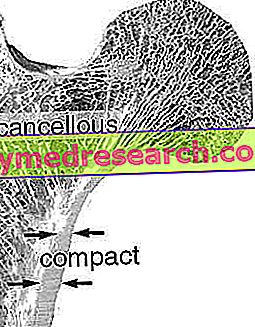Definition
With "ascites" we mean a spill of fluid in the peritoneal cavity, the abdominal lining membrane; in other words, ascites appears in the space between the abdominal organs and the tissue that covers the abdomen. Ascites is one of the most common complications of liver cirrhosis.
Causes
In addition to liver cirrhosis, many other diseases can predispose the patient to the onset of ascites: alteration of intestinal absorption, colon and liver cancer, hepatitis, heart failure, portal hypertension (often associated with water and sodium retention by part of the body), severe malnutrition, pancreatitis, tuberculosis.
Symptoms
It is estimated that 33% of ascites patients do not complain of any symptoms, and that the fluid discharge into the abdominal cavity is diagnosed by accident. In some patients, ascites is manifested by mental confusion, muscle weakness, breathing difficulties, abdominal pain and distention, encephalopathy, fever, gynecomastia, loss of appetite, jaundice. In severe forms, ascites can induce coma.
Information on Ascites - Ascites Drugs is not intended to replace the direct relationship between health professional and patient. Always consult your doctor and / or specialist before taking Ascite - Ascites Drugs.
drugs
Given the complex mechanism that is established in the context of ascites, before describing the treatments and medications indicated for its treatment, a brief summary scheme is described below, which describes how to reach the transudation of liquids in the peritoneal cavity starting from from liver disease:
Hepatic disorders → blood flow impeded normally in the liver → increased portal pressure → za spleen volume (splenomegaly) → ↓ circulating blood volume (hypovolemia) → activation of the renin-angiotensin-aldosterone system and the sympathetic system → ↑ ↑ renal sodium, tachycardia → fluid accumulation in the peritoneal cavity (ascites).
The goal of treatment for ascites is the cure of the underlying disease; there are numerous intervention strategies. Here are the most frequent:
- Behavior modification: it involves bed rest and sodium restriction at only 1.5-2 grams per day
- Drug therapy: involves the administration of diuretics to remove excess fluids (spironolactone and furosemide), albumin, antibiotics to be used in cases of proven bacterial co-infection (eg cefotaxime, cefoxitin, amoxicillin and clavulanic acid)
- Don't drink alcohol
- Evacuative paracentesis: the objective is to eliminate the liquids accumulated in the abdominal cavity. The therapeutic practice makes use of the aid of a needle that is inserted directly into the abdomen, so as to favor the elimination of excess fluids by aspiration. In similar situations, the concomitant albumin infusion is recommended in order to favor the re-expansion of the plasma volume.
- Liver transplantation: reserved for those patients who do not report any appreciable benefit after taking medication
Diuretics for the treatment of uncomplicated ascites : by reducing the volume, these drugs are able to significantly reduce portal pressure.
- Spironolactone (eg Aldactone, Uractone, Spirolang): this is a powerful diuretic drug (belonging to the pharmacological class of potassium savers), used in therapy for the treatment of ascites at the initial posology of 100 mg a day; subsequently, progressively increase the dose up to a maximum of 400 mg a day. Spironolactone is also available in combination with hydrochlorothiazide (eg Aldactazide, Spiridazide), another potassium-sparing drug: in this case, it is recommended to start therapy by taking 4 tablets per day orally, formulated with 25 mg of spironolactone and with 25 mg of hydrochlorothiazide. The drug is also available in 50 + 50 mg tablets: in this case, only two tablets per day are needed. If after 2-4 days no noticeable improvements are observed, it is advisable to increase the dose gradually, every 2-3 days, up to a maximum of 200 + 200 mg. Long-term treatment with this drug - as well as its abuse - can induce decreased sexual desire, impotence and gynecomastia.
- Furosemide (eg Lasix, Spirofur): to be used in combination with spironolactone when the monotherapy with the latter drug does not report the desired therapeutic results. The combination of spironolactone + furosemide is also recommended to avoid nocturia. As an indication, for ascites treatment, it is recommended to start therapy with a minimum dose of drug (40 mg); eventually, increase the dose gradually up to a maximum of 160 mg / day.
- Bumetanide (eg Bumex) second choice drug for ascites treatment. The indicative dosage suggests taking 0.5-2 mg of drug per day, by mouth; alternatively, take the drug intravenously or intramuscularly at a dose of 1 mg per day. It is possible to take the active ingredient also for continuous intravenous infusion: in this case, the indicative dosage is 1 mg / hour, for a maximum of 12 mg a day.
- Torsemide or Torasemide (eg Demadex, Diuresix): the drug is a loop diuretic used in therapy for ascites treatment; it is not a drug of first choice as is furosemide and spironolactone. Indicatively, take 5-10 mg of drug orally or intravenously, once a day.
- Ethacrinic acid (eg reomax): the drug is a loop diuretic. For the treatment of ascites, it is recommended to take the drug at a dose of 50 mg a day, orally or intravenously, preferably with food. The etacrinico acid is advised in case of ascites ascertained, if the spironolattone and the furosemide did not report appreciable benefits.
- Triamterene (eg Dyrenium): the drug is a diuretic also indicated for the treatment of ascites; the indicative dosage foresees to take 100 mg of active, twice a day, by mouth. The drug is also available in association with furosemide (eg Fluss): in this case, it is recommended to take 1-2 tablets per day, every other day (each tablet is formulated with 25 mg of triamterene and 40 mg of furosemide).
Antibiotic drugs for the treatment of bacterial superinfections in the context of ascites:
- Amoxicillin + clavulanic acid (eg. Amoxicillin and Clavulanic acid Sandoz): it is recommended to take 1 gram of amoxicillin associated with 200 mg of clavulanic acid for bacterial infections in the context of ascites. Continue the therapy for 7-10 days, following the instructions given by the doctor.
- Cefotaxima (eg Cefotaxima, Aximad, Lirgosin, Lexor): the drug is a third-generation cephalosporin. Indicatively, administer 2 grams of the drug every 8 hours. This pharmacological treatment is particularly suitable for cases of ascites associated with pancreatitis.
- Cefoxitine (eg Mefoxin): second-generation cephalosporin used in therapy for the treatment of ascites; the treatment with this active ingredient is particularly indicated for the superinfections supported by Enterococci. Indicatively, take 1 gram of drug every 6-8 hours, for 3-7 days.
- Aztreonam (eg Cayston) the indicative dose is to take 500 mg of the drug every 8 hours. The duration of therapy should be determined by the doctor based on the severity of the symptoms and the infection.
Albumin : for the treatment of cirrhosis-dependent ascites in the advanced stage.
The administration of albumin from the outside is indicated also and above all in the evacuative paracentesis for the treatment of ascites resistant to pharmacological treatments: following an evacuative paracentesis (volume of ascitic fluid removed> 5 liters), it is recommended to inject albumin via intravenous with a low sodium content, indicatively at a dose of 40g / paracentesis (corresponding to 6-8 grams per liter of removed ascitic fluid). It is also recommended not to exceed the infusion rate of 16 grams per hour.
One step back: let's remember briefly that albumin is a protein whose function is very important for the organism; albumin is implicated in the complex mechanism of regulation of the plasma oncotic pressure and the transmission of vitamins, drugs, free fatty acids and steroid hormones. The clinical and pathological picture of severe ascites is also characterized by hypoalbuminemia: for this reason, it is necessary to take albumin from the outside, following evacuative paracentesis.



